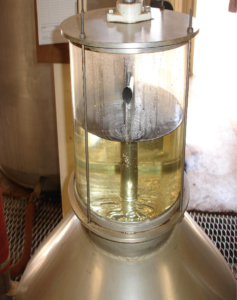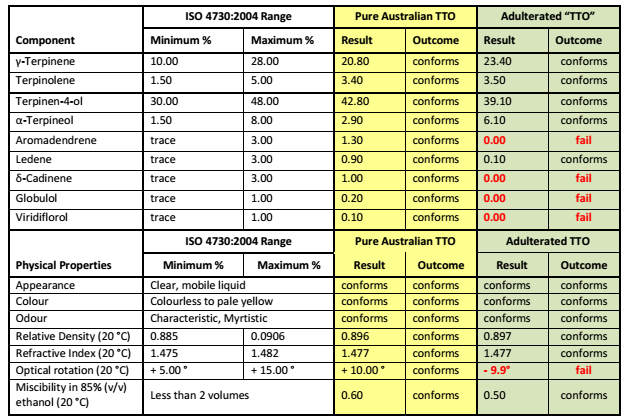Photo courtesy of Australian Tea Tree Industry Association, ATTIA
Products like Tea Tree oil are plant based and naturally derived essential oils with known and highly prized therapeutic and cosmetic properties. These factors make them valuable commodities not only for consumers who make a conscious choice to purchase the product but also for manufacturers who can use them to manufacture and sell products to discerning customers.
When a naturally derived product is adulterated by diluting it with either synthetic or other naturally derived sources ( ie components that have been deferentially distilled from other essential oils) this is a very serious issue: it is no longer a naturally derived product and because the production process for the synthetic or other components is usually not carefully controlled there is a real risk that contaminants, some of them potentially harmful to the health and well-being of both consumers and workers who handle the material, are included.
Tea Tree oil is produced and sold to discerning customers because it is a natural product which is proven to confer benefits to the consumer. Adulteration destroys this and therefore devalues the product in the eyes of the customer. The perpetrators of this fraud also reap huge profit by selling cheaper adulterants as a pure, natural product and so free-ride on the years of effort and research by producers and manufacturers as well as the trust of the customer.
When Tea Tree oil is adulterated ATTIA has identified that the perpetrators most commonly use industrial waste by-products from factories where other essential oils are "normalized" because this is the cheapest source. An example of this is where a sub-standard Eucalyptus or Pine essential oil is re-distilled to remove any contaminants and also to boost the % of the main ingredient- for Eucalyptus this is 1,8-cineole (eucalyptol) and for Pine this is alfa pinene. Some of the compounds removed in this process are terpinen-4-ol (the principle compound for Tea Tree oil) and sabinene. It is very easy to catalytically convert sabinene to terpinen-4-ol by the way.
While these by-products are in themselves not harmful, the processes used and the care taken in the production process is in many instances very poor. Often the by-products of the process contain compounds that are never found in 100% pure Tea Tree oil and often include synthetic products such as phthalates which are known to be endocrine disruptors (chemicals that at certain doses, can interfere with endocrine (hormone)systems. These disruptions can cause cancerous tumors, birth defects, and other developmental disorders) as well as pesticides and an unknown number of other potentially harmful compounds.
Adulteration undercuts and devalues the reputation of an important essential oil and also damages a viable and iconic Australian industry with a far cheaper product being sold as "pure" under the banner of decades of research which has been sponsored in the main by the Australian Tea Tree oil producers. This research has demonstrated that Pure Australian Tea Tree oil is a safe and efficacious natural therapeutic product with proven antibacterial, anti-fungal, anti-viral and anti-inflammatory properties. This fraud is frustrating the efforts of Australian Tea Tree farmers who strive to produce a high quality, environmentally friendly and natural product because the adulterated material is offered as "100% pure" at far less than the price of production for real 100% pure Tea Tree oil.
As you have learned in previous lessons, when we talk about Tea Tree oil, we are talking about Melaleuca alternifolia, terpinen-4-ol type which produces the most desirable oil profile. The ISO have established Standards with specific parameters to help suppliers to identify and so ensure that any Tea Tree oil they sell is the best possible quality for this particular species and for this particular chemo-type. We will discuss this in more depth in the following lesson.
Most people are also unaware that there are two other, less desirable, chemo-types from this plant. This produces Tea Tree oil that is not " T40/C3" and so is harder to market. As we learned earlier countries other than Australia have used seed from the incorrect chemo-type and so produce Tea Tree oil that the market doesn't want: this often a reason for adulteration as it allows an unscrupulous trader to 1) make a large profit and 2) sell a sub-standard product as a top quality product. This of course can lead to the really unacceptable practice of just selling pure industrial waste as Tea Tree oil with potentially disastrous consequences for the end-user and the manufacturer who has been duped.
As you can imagine producers who invest in and produce 100% pure Tea Tree oil have become increasingly frustrated with the way the market for Tea Tree oil deliberately an cynically adulterates their product with industrial by-products and continue to sell it as "100% pure" with a single motive: profit at the expense of bona fide producers.
As we saw in previous lessons, there are three main chemo-types in Melaleuca alternifolia:
- Terpinen-4-ol type which produces predominantly terpinen-4-ol (usually 30-48%).
- 1,8 cieneole type which produces predominantly 1,8 cineole (usually 12-48%).
- Terpinolene type which produce predominantly terpinolene and/or alfa-terpineol.
So to conform to ISO 4730: 2004 and therefore qualify as TTO the correct chemo-type must be selected hence the specific mention of “…terpinen-4-ol type” in the title.
The definition of ADULTERATED is: to render (something) poorer in quality by adding another substance
In the case of TTO there appears to be three ways this is done:
- The product started out as TTO steam distilled from M. alternifolia that is of poor quality and does not pass the Standard – usually the terpinen-4-ol is too low, the 1,8 cineole and/or para-cymene is too high or the product is heavily oxidised or otherwise contaminated and therefore un-merchantable. In these instances the product is adulterated by adding terpinen-4-ol from ‘normalising’ other essential oils to get it up to close to the “T40/C3” standard most people want; limonene is sometimes (though not always) added to correct the optical rotation to fit the Standard. Who knows what else is added during this process – the additives are uncontrolled waste and a wide variety of contaminants never found in pure TTO have been identified and this varies from batch to batch.
- A good quality TTO is diluted with the product described in 1) above to extend it – the classic definition shown above.
- Pure industrial waste is doctored to approximate TTO and sold as such.
(SOURCE: Tony Larkman, private communication, 2016).
About this you can use this link.
Another article "How ISO 4730:2004 and AS 2782-1997 Standards Help Identify Fraudulent Tea Tree Oil" also provides in-depth information (use this link to download it) and the table below is taken from this article; it introduces for the first time some of the other characteristics (Physical Properties) that we mentioned earlier that are also used to determine the purity of a Tea Tree sample.
Note that the pure Australian TTO conformed to all of the parameters in the standard and can therefore be sold as such. However the adulterated sample failed 7 of the total 22 parameters.
It is possible and maybe even likely that the product was originally an essential oil of some sort but it would have been of very poor quality (eg low terpinen-4-ol and high p-cymene). In an attempt to make the product conform, the perpetrator would have added synthetic terpinen-4-ol has a different optical rotation to that found naturally in TTO so they would then also add synthetic limonene to balance this out.
If you look at the results, they got the terpinen-4-ol level spot on so it conforms; but they weren't good at the rest:
1- The alfa tepinene level is too low (0,2%) because too much synthetic terpinen-4-ol was needed to get close to the desired 40% level.
2- The limonene level is too high (3,4%) because they needed to add it to the product to balance the optical rotation.
3- Have a look at the p-cymene level: just inside the specification. This must have been really high before it was adulterated indicating it was probably very oxidized due to age, poor storage or both.
4- Aromadendrene, delta cadinen, globulol and viridiflorol levels are below the limit of detection. This is precisely why these minor components are in the Standard: They are always in a pure, natural sample of TTO; if they are not present in at least a trace amount it is a signal that something is wrong.
5- The optical rotation is minus (-) 9.9º. Despite overdoing the limonene they still didn't get the optical rotation right. This is the equivalent of offering TTO with zero terpinen-4-ol and hoping no one will notice.
BUT, WHY IS THAT? WHY TTO IS SO ADULTERATED?
Let see what Tony larkman say about this:
"In the past 2 decades a great deal of M. alternifolia seed has been exported from Australia to other countries including China, Malaysia, South Africa, America, Madagascar and Kenya. This seed is sourced from the bush and in many instances the collectors are not as knowledgeable as they should be which resulted in much of the seed being collected coming from the incorrect chemotype, usually the 1,8 cineole or intermediate types because the terpinolene has a very distinctive odour and is easy to pick up in the field while the odour differences between the pure terpinen-4-ol and 1,8 cineole chemotypes are more subtle and it takes a really keen nose to pick these in the field and even then it should be checked with a CG. This means places like China started producing a high 1,8 cineole TTO which failed to meet the market demand for 40% terpinen-4-ol/3% cineole (so called T40/C3) because terpinen-4-ol and 1,8 cineole production in the plant is inversely related. So they started boosting the terpinen-4-ol with industrial waste to get it up to the magical T40/C3 the market wants and to make sure the optical rotation was consistent with real TTO they also added limonene which is highly optically active. Then someone realised they could make an absolute fortune (it has been estimated the margin is up to 500%) if they just sold the industrial waste as 100% pure TTO and a new industry was born. Over time they got lazier and often didn’t even bother to get the parameters anywhere near the requirements for IOS 4730 and margins rose. This is one of the reasons TTO remained at around or below US$ 25/Kg for so many years – they could easily undercut producers at this level and still make fat profits".
(SOURCE: Tony Larkman, private communication, 2016).
In conclusion, the Tea Tree oil market looks like this:
- A large supply of non ISO 4370 compliant Chinese oil (often highly oxidized or contaminated) is being blended and sold as "tea tree oil" motivated purely by profit and at the expense of producers of genuine pure tea tree oil.
- There is plentiful supply of cheap waste products from the "normalization" of other oils eg Pine, Eucalyptus, Sandalwood, Fennel, Basil etc.
- Some trading houses are unwilling to develop reliable supply chains for constant supply of quality cheap adulterated material. This sometimes forces sporadic purchasing with little or no regard to Quality Assurance (QA) and fosters the proliferation of adulteration.
- Adulterated oil is cheaper to produce and buy; some traders and manufacturers are willing to turn a blind eye to the issue of quality to remain competitive.
- Genuine lack of knowledge in the market on proper identification methods and a lack of QA protocols to manage and reduce the risk of this occurring.
(SOURCE: letter from Tony Larkman to Robert Pappas, 2014 october).
This is, as we mentioned at the beginning, a complicated topic so please make sure you review and understand this lesson before you go to the next one.





No Comments